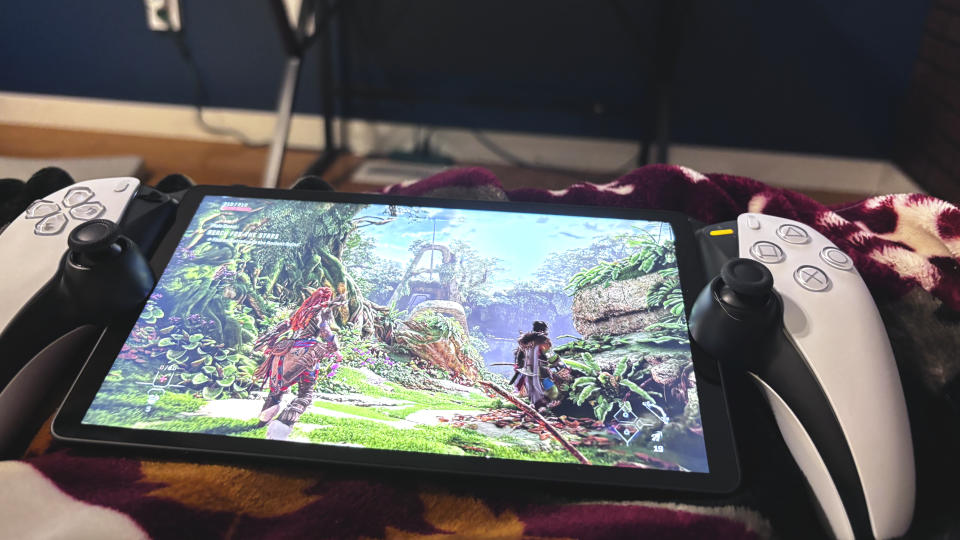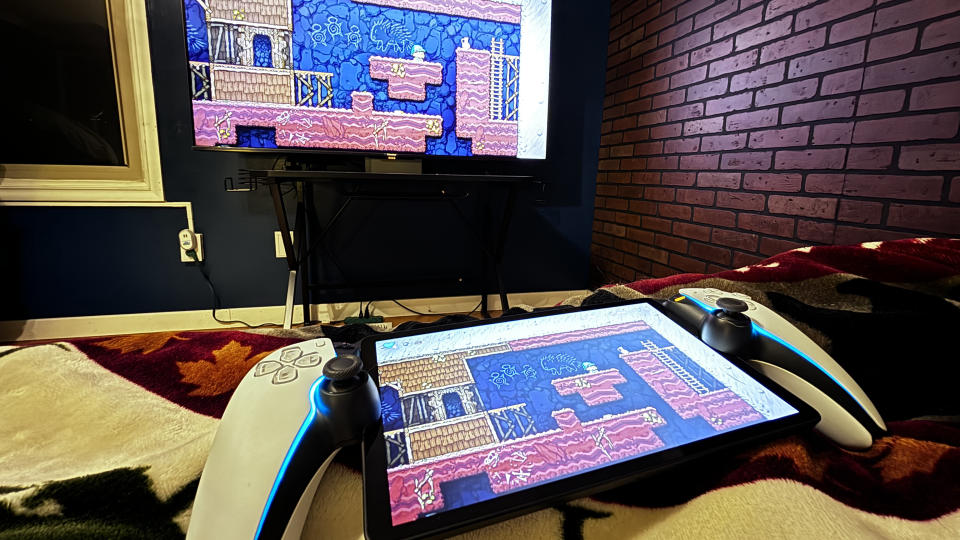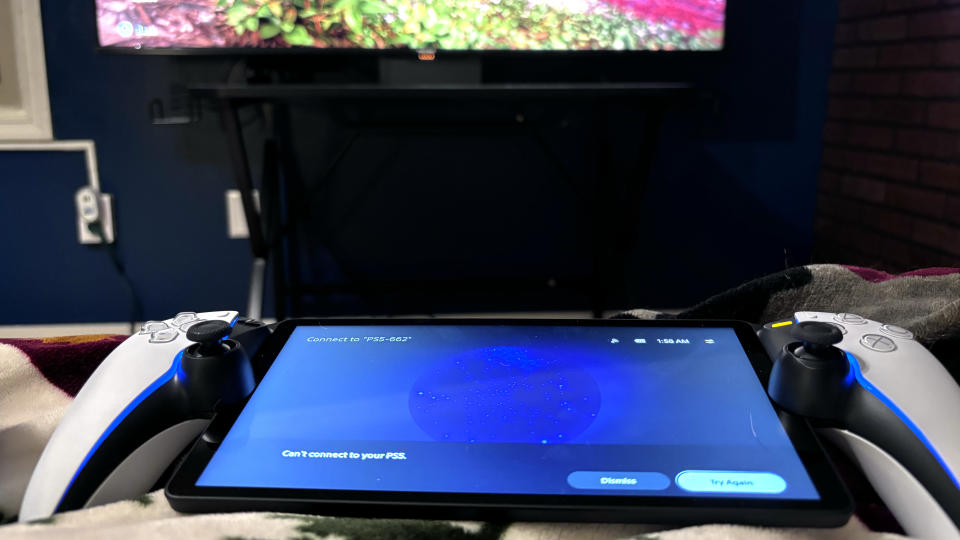PlayStation Portal review
When you buy through links on our articles, Future and its syndication partners may earn a commission.

On paper the PlayStation Portal sounds like a great idea — it allows you to play your PS5 anywhere with a solid, stable Wi-Fi connection. Unfortunately, that theory of a perfect, lag-free experience dissolves pretty much immediately when you put it's promises to the test in a real-world environment.
Between latency issues on my 300Mbps / 300Mbps wireless network and the inability to stream content from services like Netflix, Hulu and YouTube due to DRM rules, the Portal just couldn’t deliver an enjoyable experience or one I’d feel comfortable recommending, even with hardware patches and the latest updates.
Its 8-inch LCD screen offers Full HD resolution — which can look nice for a few seconds at a time — but, in my experience, was often filled with visual artifacts and stutter. The latency caused audio playback to become choppy, turning some of the most emotionally poignant moments from games like God of War: Ragnarok, Star Wars Jedi: Survivor and Horizon Forbidden West into meme-worthy snippets of video. In Sony’s defense, however, our second review sample used by my colleague in the U.K. fared much better, with less stuttering and noticeably lower latency.
This, in short, is the issue: It's a device that lives and dies not only by the speed of the network you're connected to, but also the distance you are from the router and even the layout of your home or apartment. The PlayStation Portal will likely deliver on its promise of a latency-free experience for some buyers, but if my experience is anything like the one you’ll have, I’m not sure Sony’s game-streaming-only handheld console is a good solution to what I think is a very niche problem.
PlayStation Portal review: Price and release date
The PlayStation Portal launches on November 15 for $199.99 / £199.99, roughly twice the cost of the Backbone One PlayStation Edition Mobile Gaming Controller iPhone that launched back in July of 2022. In the box, you get the handheld and a USB-C to USB-C charging cable.
It's worth pointing out here that there is no 'dock' for this accessory like the Nintendo Switch has, and it requires you already own a PS5 in order to use it. That fact alone means you're sinking both $199 into this device and around another $500 into the PS5 if you don't already own one.
PlayStation Portal review: Design

Considering the price and knowing that you already have a phone that’s capable of remote play using a Bluetooth controller — either the Backbone One or otherwise — why would you even consider a PlayStation Portal?
Well, from a pure design standpoint, the PlayStation Portal makes sense: It offers a Full HD screen that’s larger than the ones on even the best smartphones and the small touches like triggers with haptic feedback make it feel more like you're playing your PS5 compared to using a standard Bluetooth controller that wouldn’t have them.
Holding the PlayStation Portal genuinely feels like holding a PS5 controller with a tablet in between your hands. Switching back and forth between it and a PS5 controller requires no re-wiring of your brain — all the buttons are located in the same place and they all feel exactly the same when you press them. It's worth noting that the control sticks are slightly smaller than on a normal DualSense controller as they're the same ones on the Sense Controllers that ship with the PSVR2.
It’s faint praise to be sure, but considering how many awful MFi controllers are on the market, it’s nice that Sony really followed through on matching the Portal to the DualSense nearly one-to-one.
PlayStation Portal review: Performance

Performance is going to vary based on your connection speed (both upload and download rates) and factors like the distance between your console and your Wi-Fi router, whether you run your PS5 hardwired or not, and how far you plan on sitting away from said wireless router when you use the PlayStation Portal. Because of this, I can't predict with any certainty what your personal experience will be like.
What I can tell you, however, is that with a 300Mbps connection both upstream and downstream, my experience was less than ideal: Gameplay was choppy most of the time, and the few moments it wasn't, didn't really impress me.
To put the Portal through its paces, I played a graphically intense game (Horizon Forbidden West) and an indie game that wasn't so resource-heavy, but one that required exact timing to work (Spelunky 2).
Despite being significantly less graphically intensive than Horizon, the latency in Spelunky 2 made it feel next-to-impossible to get through a level. Often, the delay would cause me to miss a crucial jump or time an attack a second too late, resulting either in a lost heart or a complete wipe. In games where timing is everything, using the Portal is going to significantly ramp up the difficulty.
Playing Horizon Forbidden West, I had similar difficulties. While the game doesn't require laser precision in terms of timing, simply navigating the world led to severe artefacting. At some points, the resolution would drop so low that the closed captioning I turned on to better hear the characters was illegible.
After spending some time tweaking the settings on my router, I was able to boost the download speeds to the PS5. The result was a far more stable experience, though one that would still suffer from input delay and periodic hiccups. It goes to show that if you're motivated to make the PlayStation Portal work on your network, it certainly can be done — but it might not work right of the box for you.
To that end, I wouldn't say Sony's recommended wireless speeds of 5Mbps or 15Mbps for "an improved connection" are accurate. It's more than likely double or triple that to get a stable experience, and even then it will really depend on how far from your wireless access point you are.
PlayStation Portal review: Features
The PlayStation Portal, although sleekly designed, doesn't really come with much in the way of features — it's pretty barebones here.
The only bright spot in terms of features is that the Portal does have a built-in microphone that can be used just like the microphone on a DualShock controller. In theory, this will let you voice chat with friends...though, again, I'm not sure how great it would sound given the introduction of latency.
The most egregious error, I feel, is the fact that the Portal can't access video content from streaming services because of DRM issues. Try to use Netflix on the Portal and you’ll be met with a message that says it can’t play content via Remote Play.
The most egregious error, I feel, is the fact that the Portal can't access video content from streaming services because of DRM issues. Try to use Netflix on the Portal and you’ll be met with a message that says it can’t play content via Remote Play. The same is true for YouTube and other streaming platforms I tried.
If it came with its own version of the PlayStation platform, even a pared down one, it would at least allow you to watch content. Sadly, that isn't the case here.
Bluetooth support is another huge issue here as the PlayStation Portal will allow you to use some PS5 headphones like the forthcoming Pulse Elite Headset, but not your standard Bluetooth headphones. There is, however, a 3.5mm jack on the Portal that you can plug into directly with a standard pair of headphones.
Being able to actually download games to the console and play them locally would've been a massive improvement, but that wasn't Sony's intention with this handheld, much to the chagrin of PS Vita lovers like myself. Instead it's all Remote Play all the time.
To Sony's credit, they have continued to support the PlayStation Portal with new features via software updates. While they have yet to resolve the lack of video content or Bluetooth support, a new system patch launched this month adds the ability to connect to public Wi-Fi networks that require additional validation steps (though you'll need a mobile device), alongside new visual feedback on the touchpad areas of the 8-inch display and the option to add a battery percentage indicator.
PlayStation Portal review: Battery life
Sony says the PlayStation Portal has around a four-hour battery life, which I found to be slightly optimistic. Most times I could only get around three hours per charge, though I had the brightness and volume turned up slightly above average.
Charging is done via the included USB-C cable and you should be topped up in well-under an hour.
PlayStation Portal: Verdict
PlayStation Portal: Verdict
The PlayStation Portal is going to be divisive. Some gamers are going to have a relatively painless experience and others are going to call this a $200 paperweight. For me, in my dozen or so hours of testing with the device, it was the latter. But I do know that other reviewers, including our own Rory Mellon, had a much better experience on their home networks.
That being said, because it's such a hit-or-miss device and there's no built-in hard drive solution to store and play games locally, you're at the mercy of every wireless network you plan to use the PlayStation Portal with. Some of those will be good, but many will not. And because of that, it's hard to give it a positive review.
It's easy to ask 'what if?' with the PlayStation Portal. If it had done several things differently — like add storage space for local games — it'd be easier to recommend. But what you see is what you get with the PlayStation Portal. It's a device that lives and dies by your network connection and the fact that you already own a PS5 and regularly don't have access to the TV it's connected to. If that works for you, then the PlayStation Portal is worth trying...but I would save my money and buy a full-fledged gaming handheld like the Steam Deck OLED or Nintendo Switch instead.
Nevertheless, the PlayStation Portal has been surprisingly popular with gamers since its launch, and much like the PS5 required for its use, was practically impossible to find in stock for several months after launch. Finally, in May 2024, we're beginning to see more consistent supply but check our guide to where to buy a PS Portal for the latest updates.
